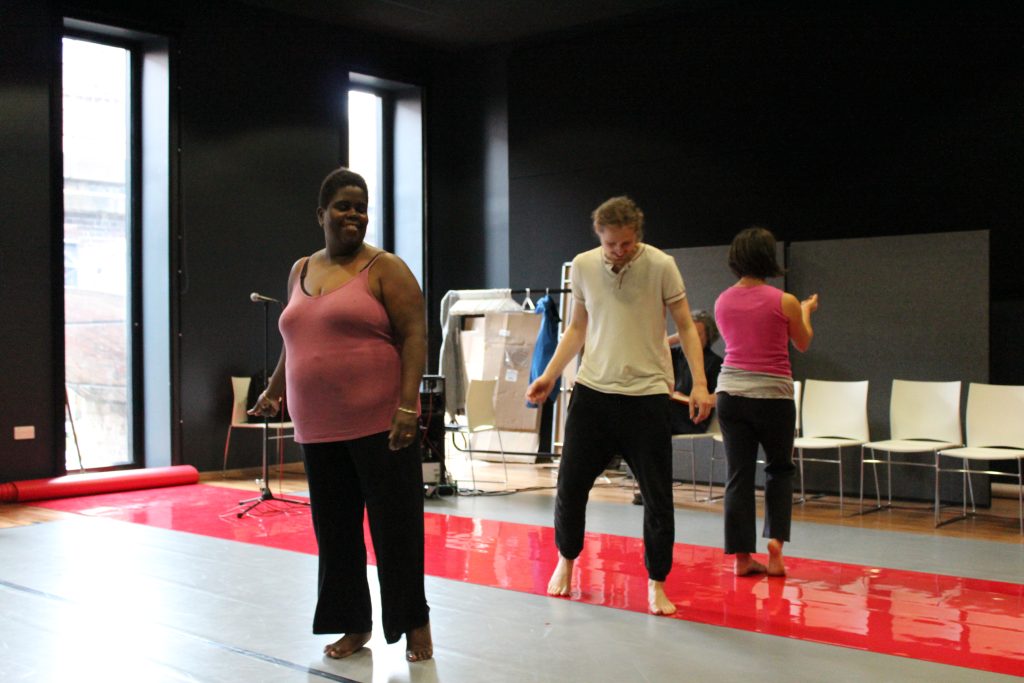Quarantine invites blogger and academic Dani Abulhawa into the creative process as we enter the last few weeks of making our new work, Wallflower…
Thursday 6th August
The performers are halfway through the creative process, when I arrive to observe. I enter the rehearsal room and take a seat, with a feeling of needing to catch up with the steps that have already been established, with the routine. It is the morning, early on in the rehearsal day, and the performers are warming up to a soundtrack of rock classics, as they stretch and play. I witness ‘the salmon’, a choreographed movement up stream (from one side of the space to the other), several moments of synchronicity, where each performer seems to be infecting the movement of another, and then they cluster together hips swaying very gently, in a miniscule fashion.
The rehearsal moves on into remembering and working through the steps of a dance. They repeat them over again. Deep in the minutiae of steps, I am watching intently, and I feel I am with them. I wonder whose dance this is? What it is it’s story? Wallflower is a performance that begins with the idea of remembering all the dances you’ve ever danced. The working process starts from what is referred to as ‘The Game’, where each performer goes through the process of remembering, going over, perhaps re-performing, which sets off a memory in someone else, of a dance of their own. Each one is being captured in ‘The Archive’, which the performers’ will have at their disposal during the performance.
As if reading my thoughts, Richard comes over to me and explains that this choreographed routine is the only dance in the piece that is rehearsed and established before-hand, and I quite like that this is the first thing I have seen. It is the only dance that is set in the piece; it’s a dance that each performer will share in the future. Another dance to commit to memory. From my distance I really notice the visibility of when the steps of this dance are being remembered, compared with moments when they are being… well, felt.
A long period of moving is followed by conversation. I am within earshot and pick up certain things. On the subject of remembering during ‘The Game’, Richard offers, ‘don’t be afraid of letting the thinking show.’ The group discuss a tension between dancing the dance and talking the dance in the show: the three approaches have an equal weighting in this piece: 1. Dancing the dance and talking, 2. Dancing the dance and not talking, and 3. Talking the dance. It feels a permissive, fluid, generous creative process.
Running in the background of my own processing of this rehearsal is an ongoing review of the repertoire of my own dances. I think about those dances that happen at 6.30am for an audience of one (cat), dances with my students, dancing at weddings, dance classes as a child. I imagine the finished work is likely to have something of this generative quality for the audience, where memories of the viewer mingle with those presented by the performers.
Richard reflects on how motorways, bridges and routes-through seem to be themes that are cropping up. He mentions this at the precise moment my attention is drawn to the regular passing of trains on the railway bridge directly outside the window of the rehearsal room; I appreciate the rhythm of that train-line and I wonder how much it has infected this creative process. When I zone back into the conversation, the group are discussing a sexy dance. I make a mental note to look out for it.
Conversation moves on to ‘The Middle Eight’; the structure of the show mirroring that of a piece of music in which the eight bars in the middle of the song take on a different character to the rest of the piece. The group settle on an idea about remembering stories they’ve read and Sonia starts to tell one, as everyone in the room listens. Afterwards the group discuss how Sonia tells the story, that process of trying to remember, and there is a decision made to avoid telling too much of what the story, or elements of the story, mean.

I keep reflecting on that phrase ‘wallflower’, which is used to describe a person (often a girl) at a dance that doesn’t have a partner, thinking about how relevant it seems to the role of the audience – of me, observing – and of audiences more generally.
Throughout the conversations the performers are sat together with Richard in a circle; James and Sonia are on chairs, Jo is on the floor. My attention keeps returning to the small movements they’re each making – stretching arms in the air, a scratch of a head, legs folding and unfolding, as if I am seeing them always dancing.
By Dani Abulhawa
Find out more about Wallflower:
Find out more about Dani:



